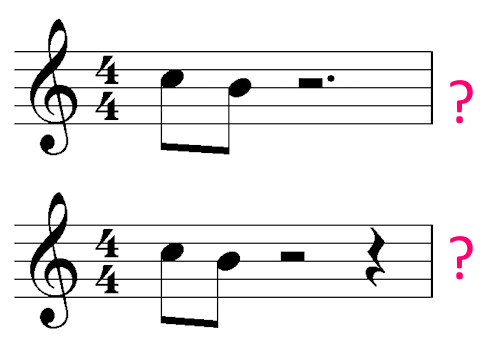Rests Review
| Rest | UK rest Name | US REst Name |
|---|---|---|
| Semibreve/Whole bar rest | Whole note/whole measure rest | |
| Minim rest | Half rest | |
| Crotchet rest | Quarter rest | |
 | Quaver rest | Eighth rest |
| Semiquaver rest | Sixteenth rest |
How to Add Rests to a Melody
The type of rests used in a melody depend on how long the silence is AND they need to match the beats shown by the time signature. Rests should make up complete beats. Using the correct type of rest makes the beat easy to see. Using the wrong type of rest obscures the beat. In quadruple time signatures (like 4/4 and 4/2) you also need to make sure that the 3rd beat of the bar is easy to see, because it’s the second strongest beat in the bar.
What rests are needed to complete this melody?

The time signature is 2/2, so we need to have 2 minim (half note) beats per bar.
In bar 2, the first two beats are complete. But there are only 1.5 beats in the second half of bar 2, where in fact we need 2. So we need a quaver (eighth) rest to complete the full minim (half note) beat. Here’s the rest added to the bar:

Try to work out the other rests for yourself. Remember that your rests need to make complete beats. Think carefully about the last bar – you need to complete the first minim (half note) beat first, then finish the bar off, so you’ll need two rests in the last bar. Hover your mouse over the stave to reveal the answer.
Is this wrong?
Look at that last bar again. Students often wonder if it’s wrong to write something like a dotted minim (dotted half) rest, or a minim followed by a crotchet (half followed by a quarter), in this type of bar. After all, it’s just a silence isn’t it, so does it really matter?

Well, the short answer is, yes, it does matter! You must look carefully at the time signature, and you must make up complete beats before you do anything else. Incorrectly notated rests can cause confusion.
Here’s another example. In 4/4, there are four crotchet (quarter note) beats per bar. So how should you fill up a bar like this with rests?

So far the notes in the bar make up a total of 3 beats (1½ +½+½+½). Since we need 4 in total, you might be tempted to write a crotchet (quarter) rest here, but you’d be wrong.
The rests need to make it obvious to the eye where the beats of the bar fall. If you write a crotchet (quarter) rest, the position of beat 3 will be hidden – somewhere in the middle of that rest.

Instead, you need to write a quaver (eighth) rest first, to finish off the second beat, then another one to begin the third beat.

To Sum Up
- Write rests that equal ONE BEAT and place them ON the beat (not between the beats).
- Always combine rests that equal TWO, THREE or FOUR beats into longer rests, but ONLY if they fall on the strong beat of the bar. The strong beats are beat 1 (all time signatures), beat 3 in 4/4 (third crotchet/quarter note) and beat 2 in 2/2 (second minim/half note).
- If a rest follows a note which is less than one beat, FINISH that beat first.
Here are some examples of correct and incorrect rest writing.

2/4
1: correct, 2: rest on off beat, 3: rest on off beat, 4: correct (half beat finished first), 5: rest on off beat.
3/4
1: correct, 2: combined beat rest on weak beat, 3: correct (half beat finished first), 4: half beat not finished first, plus rests on off beat, 5: correct, 6: rest on off beat, 7: correct (combined rest on strong beat).
4/4
1: correct, 2: rests not combined, 3: correct (rest combined on beat 3), 4: combined rest on weak beat, 5: correct (half beat finished first), 6: half beat not finished first, rests on off beat).
3/8
1: correct (rests not combined because weak beats), 2: rests combined on weak beat, 3: correct, 4: rests not combined on strong beat.
3/2
1: correct (rests not combined because weak beats), 2: rests combined on weak beat, 3: rests equal half beat in this time signature, 4: correct (2nd minim/half note beat finished first), 5: rest on off beat, 6: correct (rest combined on strong beat).
Adding Rests Exercises
Point your mouse at the stave (tap on mobile devices) to reveal the answers.
Writing Rests
In each of the numbered spaces add the rest named below, as shown in the answer to [1].
[1] crotchet (quarter) rest[2] quaver (eighth) rest
[3] whole bar rest
[4] dotted crotchet (quarter) rest





[5] whole bar rest
[6] semiquaver (sixteenth) rest
[7] quaver (eighth) rest
[8] minim (half) rest
[9] crotchet (quarter) rest





[10] minim (half) rest
[11] semibreve (whole) rest
[12] quaver (eighth) rest



Working Out Rests
Add the correct rest(s) at the places marked * in these tunes, to make each bar complete.







![]()





